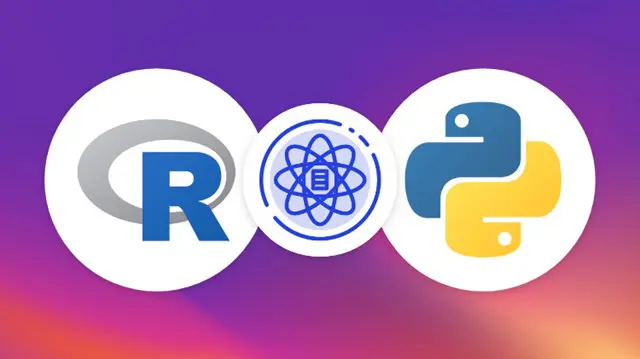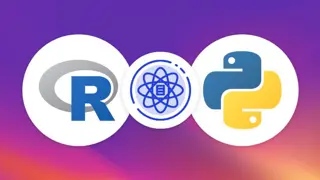
Data Science with R and Python | R Programming
Python and R programming! Learn data science with R & Python with all in one course. You'll learn NumPy, Pandas and more
Oak Academy
Summary
- Reed courses certificate of completion - Free
Add to basket or enquire
Overview
Welcome to Data Science with R and Python | R Programming course.
Python and r, r and python, python, r programming, python data science, data science, data science with r, r python, python r, data science with r and python, data science course,
Python and R programming! Learn data science with R & Python all in one course. You'll learn NumPy, Pandas, and more
OAK Academy offers highly-rated data science courses that will help you learn how to visualize and respond to new data, as well as develop innovative new technologies. Whether you’re interested in machine learning, data mining, or data analysis, Udemy has a course for you.
Ready for a Data Science career?
-
Are you curious about Data Science and looking to start your self-learning journey into the world of data?
-
Are you an experienced developer looking for a landing in Data Science!
In both cases, you are at the right place!
The two most popular programming tools for data science work are Python and R at the moment. It is hard to pick one out of those two amazingly flexible data analytics languages. Both are free and open-source.At the end of the course, you will be able to select columns, filter rows, arrange the order, create new variables, and group by and summarize your data simultaneously.
In this course you will learn;
-
How to use Anaconda and Jupyter notebook,
-
Fundamentals of Python such as
-
Datatypes in Python,
-
Lots of datatype operators, methods, and how to use them,
-
Conditional concept, if statements
-
The logic of Loops and control statements
-
Functions and how to use them
-
How to use modules and create your own modules
-
Data science and Data literacy concepts
-
Fundamentals of Numpy for Data manipulation such as
-
Numpy arrays and their features
-
How to do indexing and slicing on Arrays
-
Lots of stuff about Pandas for data manipulation such as
-
Pandas series and their features
-
Dataframes and their features
-
Hierarchical indexing concept and theory
-
Groupby operations
-
The logic of Data Munging
-
How to deal effectively with missing data effectively
-
Combining the Data Frames
-
How to work with Dataset files
-
And also you will learn fundamentals thing about the Matplotlib library such as
-
Pyplot, Pylab and Matplotlb concepts
-
What Figure, Subplot, and Axes are
-
How to do figure and plot customization
-
Examining and Managing Data Structures in R
-
Atomic vectors
-
Lists
-
Arrays
-
Matrices
-
Data frames
-
Tibbles
-
Factors
-
Data Transformation in R
-
Transform and manipulate a deal data
-
Tidyverse and more
And we will do many exercises. Finally, we will also have 4 different final projects covering all of Python subjects.
Why would you want to take this course?
Our answer is simple: The quality of teaching.
When you enroll, you will feel the OAK Academy's seasoned instructors' expertise.
Fresh Content
It’s no secret how technology is advancing at a rapid rate and it’s crucial to stay on top of the latest knowledge. With this course, you will always have a chance to follow the latest data science trends.
Video and Audio Production Quality
All our content is created/produced as high-quality video/audio to provide you the best learning experience.
You will be,
-
Seeing clearly
-
Hearing clearly
-
Moving through the course without distractions
You'll also get:
-
Lifetime Access to The Course
-
Fast & Friendly Support in the Q&A section
Certificates
Reed courses certificate of completion
Digital certificate - Included
Will be downloadable when all lectures have been completed
Curriculum
-
Data Science: Python is Easy To Learn 05:51
-
Setting Up Python for Mac and Windows : Python, Data science, R programming 17:47
-
Fundamentals of Python 1:42:16
-
Python For Data Science: Data Science 09:47
-
Using Numpy for Data Manipulation 3:25:35
-
(Optional) Recap, Exercises, and Bonus Info from the Numpy Library 51:08
-
Pandas: Using Pandas for Data Manipulation 6:57:21
-
(Optional) Recap, Exercises, and Bonus Info from the Pandas Library 3:15:45
-
Python For Data Science: Data Visualization 57:50
-
Data Science: Hands-On Projects 2:03:12
-
Environment Installation for R 08:04
-
Data Management in R 34:58
-
Examining and Managing Data Structures in R 30:46
-
Lists in R Programming 05:54
-
Arrays in Python R Programming 13:34
-
Matrices in Python R Programming 19:02
-
Data Frames in Python R Programming 36:30
-
Factors in Python R Programming 16:41
-
Data Transformation in R 1:06:56
Course media
Description
Welcome to Data Science with R and Python | R Programming course.
Python and r, r and python, python, r programming, python data science, data science, data science with r, r python, python r, data science with r and python, data science course,
Python and R programming! Learn data science with R & Python all in one course. You'll learn NumPy, Pandas, and more
OAK Academy offers highly-rated data science courses that will help you learn how to visualize and respond to new data, as well as develop innovative new technologies. Whether you’re interested in machine learning, data mining, or data analysis, Udemy has a course for you.
Ready for a Data Science career?
-
Are you curious about Data Science and looking to start your self-learning journey into the world of data?
-
Are you an experienced developer looking for a landing in Data Science!
In both cases, you are at the right place!
The two most popular programming tools for data science work are Python and R at the moment. It is hard to pick one out of those two amazingly flexible data analytics languages. Both are free and open-source.At the end of the course, you will be able to select columns, filter rows, arrange the order, create new variables, and group by and summarize your data simultaneously.
In this course you will learn;
-
How to use Anaconda and Jupyter notebook,
-
Fundamentals of Python such as
-
Datatypes in Python,
-
Lots of datatype operators, methods, and how to use them,
-
Conditional concept, if statements
-
The logic of Loops and control statements
-
Functions and how to use them
-
How to use modules and create your own modules
-
Data science and Data literacy concepts
-
Fundamentals of Numpy for Data manipulation such as
-
Numpy arrays and their features
-
How to do indexing and slicing on Arrays
-
Lots of stuff about Pandas for data manipulation such as
-
Pandas series and their features
-
Dataframes and their features
-
Hierarchical indexing concept and theory
-
Groupby operations
-
The logic of Data Munging
-
How to deal effectively with missing data effectively
-
Combining the Data Frames
-
How to work with Dataset files
-
And also you will learn fundamentals thing about the Matplotlib library such as
-
Pyplot, Pylab and Matplotlb concepts
-
What Figure, Subplot, and Axes are
-
How to do figure and plot customization
-
Examining and Managing Data Structures in R
-
Atomic vectors
-
Lists
-
Arrays
-
Matrices
-
Data frames
-
Tibbles
-
Factors
-
Data Transformation in R
-
Transform and manipulate a deal data
-
Tidyverse and more
And we will do many exercises. Finally, we will also have 4 different final projects covering all of Python subjects.
Why would you want to take this course?
Our answer is simple: The quality of teaching.
When you enroll, you will feel the OAK Academy's seasoned instructors' expertise.
Fresh Content
It’s no secret how technology is advancing at a rapid rate and it’s crucial to stay on top of the latest knowledge. With this course, you will always have a chance to follow the latest data science trends.
Video and Audio Production Quality
All our content is created/produced as high-quality video/audio to provide you the best learning experience.
You will be,
-
Seeing clearly
-
Hearing clearly
-
Moving through the course without distractions
You'll also get:
-
Lifetime Access to The Course
-
Fast & Friendly Support in the Q&A section
Who is this course for?
- Anyone interested in data sciences
- Anyone who plans a career in data scientist,
- Software developer whom want to learn python,
- Anyone eager to learn python and r with no coding background
- Statisticians, academic researchers, economists, analysts and business people
- Professionals working in analytics or related fields
- Anyone who is particularly interested in big data, machine learning and data intelligence
- Anyone eager to learn Python with no coding background
- Anyone who wants to learn Pandas
- Anyone who wants to learn Numpy
- Anyone who wants to work on real r and python projects
- Anyone who wants to learn data visualization projects.
- People who want to learn R programming, r studio
Requirements
-
No prior python and r knowledge is required
-
Free software and tools used during the course
-
Basic computer knowledge
-
Desire to learn data science
-
Nothing else! It’s just you, your computer and your ambition to get started today
-
Curiosity for r programming
-
Desire to learn Python
-
Desire to work on r and python
-
Desire to learn full stack data science with python, python and r, r programming, data science with r, r python,
-
Desire to learn r and python
-
Desire to data science r and python
-
Desire to learn python r data science
Questions and answers
Currently there are no Q&As for this course. Be the first to ask a question.
Reviews
Currently there are no reviews for this course. Be the first to leave a review.
Legal information
This course is advertised on reed.co.uk by the Course Provider, whose terms and conditions apply. Purchases are made directly from the Course Provider, and as such, content and materials are supplied by the Course Provider directly. Reed is acting as agent and not reseller in relation to this course. Reed's only responsibility is to facilitate your payment for the course. It is your responsibility to review and agree to the Course Provider's terms and conditions and satisfy yourself as to the suitability of the course you intend to purchase. Reed will not have any responsibility for the content of the course and/or associated materials.


